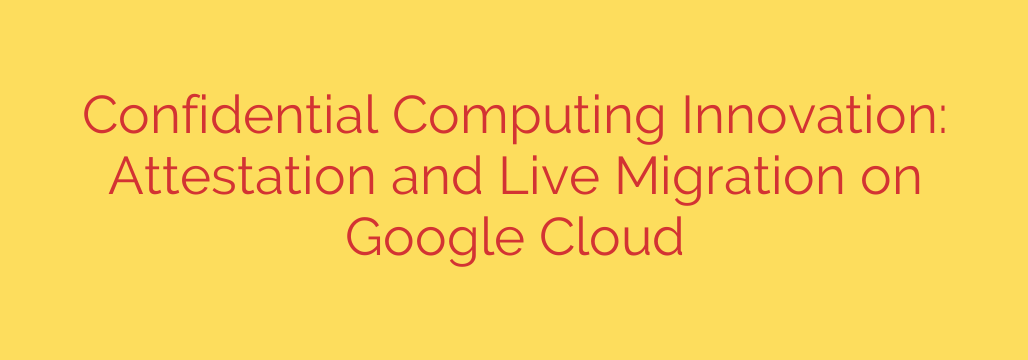
The New Frontier of Cloud Security: Verifying Trust with Attestation and Live Migration
In the world of cloud computing, we’ve become experts at protecting data in two states: at rest (encrypted on disk) and in transit (encrypted over the network). But what about the third state—when data is actively in use by an application’s CPU and memory? This has traditionally been the most vulnerable phase, but a technology called Confidential Computing is changing the game by protecting data while it is being processed.
This technology allows businesses to create isolated, encrypted environments where even the cloud provider cannot access the data being used. However, this raises a critical question: how can you be absolutely sure that your sensitive workload is running in a genuinely confidential and untampered environment? Two groundbreaking innovations provide the answer: attestation and live migration.
What is Confidential Computing? A Quick Refresher
Confidential Computing utilizes specialized hardware to create a secure, encrypted memory region for a virtual machine (VM), often called a secure enclave. This means that the entire lifecycle of your data—at rest, in transit, and now in use—is fully encrypted and protected from unauthorized access, including from the underlying infrastructure itself.
On Google Cloud, this is achieved through Confidential VMs, which leverage the power of AMD’s Secure Encrypted Virtualization (SEV) technology. But simply running a Confidential VM isn’t enough; you need irrefutable proof of its integrity.
Attestation: The Cryptographic “Proof of Life” for Your VM
Trusting a system blindly is not a viable security strategy. This is where attestation comes in. Attestation is a process that provides cryptographically verifiable proof that your VM is running in an authentic and unmodified Confidential Computing environment.
Think of it like a tamper-evident seal on a secure package. Before your application starts and decrypts any sensitive data, it can request an “attestation report.” This report contains a set of unique cryptographic measurements of the VM’s launch environment, including:
- The firmware that initialized the system.
- The host kernel managing the machine.
- The bootloader of the Confidential VM itself.
Your application can then compare these measurements against a known, “golden” set of measurements that you have pre-approved. If they match, you have high confidence that the environment is secure and has not been compromised. If there’s a mismatch, the application can refuse to run or handle sensitive data, preventing a potential breach before it happens.
Security Tip: Integrate attestation checks directly into your application’s startup sequence. Your application should only proceed with decrypting secrets or processing sensitive data after it has successfully verified the attestation report. This is a core principle of a Zero Trust architecture.
Use Case: Secure Collaboration with Confidential Space
Attestation is the foundational technology behind powerful solutions like Confidential Space. This managed environment allows multiple organizations to collaborate on sensitive datasets without ever revealing their raw data to each other or to the cloud provider.
For example, a bank and a retail company could pool their data to train a fraud detection model. The bank’s data and the retailer’s data are only ever decrypted inside the secure, attested environment of the Confidential Space. Neither party can see the other’s data, but the shared workload can process it securely, delivering valuable insights for both. This unlocks powerful collaboration scenarios that were previously impossible due to privacy and security concerns.
Live Migration: Security Meets Operational Agility
One of the most significant challenges for Confidential VMs has been the inability to perform live migrations—moving a running VM from one physical host to another without downtime. This is a standard, essential feature for regular VMs, used for host maintenance, load balancing, and hardware upgrades. Previously, using Confidential VMs meant sacrificing this operational flexibility for higher security.
That trade-off is now a thing of the past. Confidential VMs can now be live-migrated without compromising their security or integrity.
This is a major engineering breakthrough. During a live migration, the VM’s memory state must be securely transferred from a source processor to a destination processor. For Confidential VMs, this process is handled with extreme care:
- The source and destination AMD SEV-enabled processors establish a secure, encrypted channel between themselves.
- The VM’s memory state is transferred over this channel, remaining encrypted and entirely invisible to the host hypervisor.
- The encryption keys used for the VM’s memory are tied directly to the hardware and are never exposed.
The result is that your highly sensitive workload can be moved seamlessly between physical hosts for maintenance or optimization without a single second of downtime and without ever leaving its encrypted state.
The Future is Verified and Flexible
The combination of hardware-level encryption, cryptographic attestation, and seamless live migration marks a new era for cloud security. Businesses no longer have to choose between the highest levels of data protection and the operational agility they need to thrive.
By adopting these technologies, you can:
- Protect your most sensitive data and applications while they are in use.
- Verify the integrity of your cloud environment with cryptographic proof.
- Maintain seamless operations and high availability without compromising security.
Confidential Computing is rapidly moving from a niche technology to a new baseline standard for secure infrastructure, offering a robust framework for building a truly trusted cloud.
Source: https://cloud.google.com/blog/products/identity-security/innovate-with-confidential-computing-attestation-live-migration-on-google-cloud/








